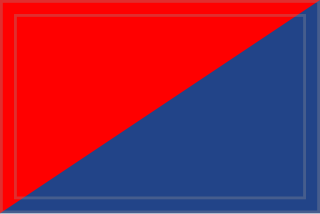
The Guards Armoured Division was an armoured division of the British Army during the Second World War. The division was created in the United Kingdom on 17 June 1941 during the Second World War from elements of the Guards units, the Grenadier Guards, Coldstream Guards, Scots Guards, Irish Guards, Welsh Guards, and the Household Cavalry.

The 4th Infantry Division was a regular infantry division of the British Army with a very long history, seeing active service in the Peninsular War and Waterloo Campaign, the Crimean and Boer Wars and both World Wars. It was disbanded after the Second World War and reformed in the 1950s as an armoured formation before being disbanded and reformed again and finally disbanded on 1 January 2012.
Operation Husky order of battle is a listing of the significant military and air force units that were involved in the campaign for Sicily, July 10 – August 17, 1943.
The Panzerkorps Großdeutschland was a German panzer corps in the Wehrmacht which saw action on the Eastern Front in 1944/1945 during World War II.
This is the complete order of battle of Allied and German forces involved during Operation Market Garden.

The 6th Armoured Division was an armoured division of the British Army, created in September 1940 during the Second World War and re-formed in May 1951 in the UK.

The 29th Infantry Brigade was an infantry brigade unit of the British Army. It was originally raised in 1914 and saw service during the First and Second World Wars and the Korean War.
Operation Battleaxe was a British Army offensive during the Second World War to raise the Siege of Tobruk and re-capture eastern Cyrenaica from German and Italian forces. The offensive's failure led to the replacement of British General Sir Archibald Wavell, Commander-in-Chief Middle East, by Claude Auchinleck; Wavell took Auchinleck's position as Commander-in-Chief, India.
The Order of battle of the East African campaign shows the ground forces of both sides in East Africa on the date that the Italians declared war on Britain and France, 10 June 1940 and for the British and Commonwealth forces involved in the 1941 offensive.
This is an order of battle of the French and German Armies at the beginning of the Franco-Prussian War in 1870.

The 6th Canadian Infantry Division was an infantry division of the Canadian Army, formed in 1942 during the Second World War. It was attached to Pacific Command. The division had a brigade sent to the Aleutian Islands Campaign, particularly at Kiska, but never saw action. The 6th Division was to have been part of a proposed Commonwealth Corps, formed for a planned invasion of Japan, but was disbanded on 31 January 1946, after the surrender of Japan in August 1945.
This is the order of battle for the ground forces involved in Operation Crusader, a World War II battle between the British Commonwealth and the European Axis Powers of Germany and Italy in North Africa between 18 November – 30 December 1941.
This is the order of battle for Operation Epsom, a Second World War battle between British and German forces in Normandy, France between 26 June and 30 June 1944.
The Allied invasion of Italy, a phase of the Mediterranean Theater of World War II, took place on 3 September at Reggio di Calabria, and on 9 September 1943 at Taranto and Salerno. Allied naval forces landed American and Commonwealth troops on the beaches of southern Italy where they faced resistance from Axis forces.
The Battle of Monte Cassino order of battle for January 1944, is a listing of the significant formations involved in the fighting on the Winter Line January 1944, during the period generally known as the First Battle of Monte Cassino.
In September 1939, the British Army was in process of expanding their anti-aircraft and mobile assets. Among these new changes was the formation of Anti-Aircraft Command which was formed on 1 April 1939, and the 1st Armoured Division formed in 1937. The list below will include the British Army units, colonial units, and those units which were in the process of formation.

The Beauman Division was an improvised formation of the British Expeditionary Force (BEF) during the Second World War, which fought in France against the German 4th Army in June 1940, during Fall Rot, the final German offensive of the Battle of France.
The Order of battle, Keren 1941 shows Italian army forces that participated in the Battle of Keren from February to March 1941 and British troops in Sudan on 20 January 1941, which participated in military operations against Eritrea during the East African Campaign 1940–1941.